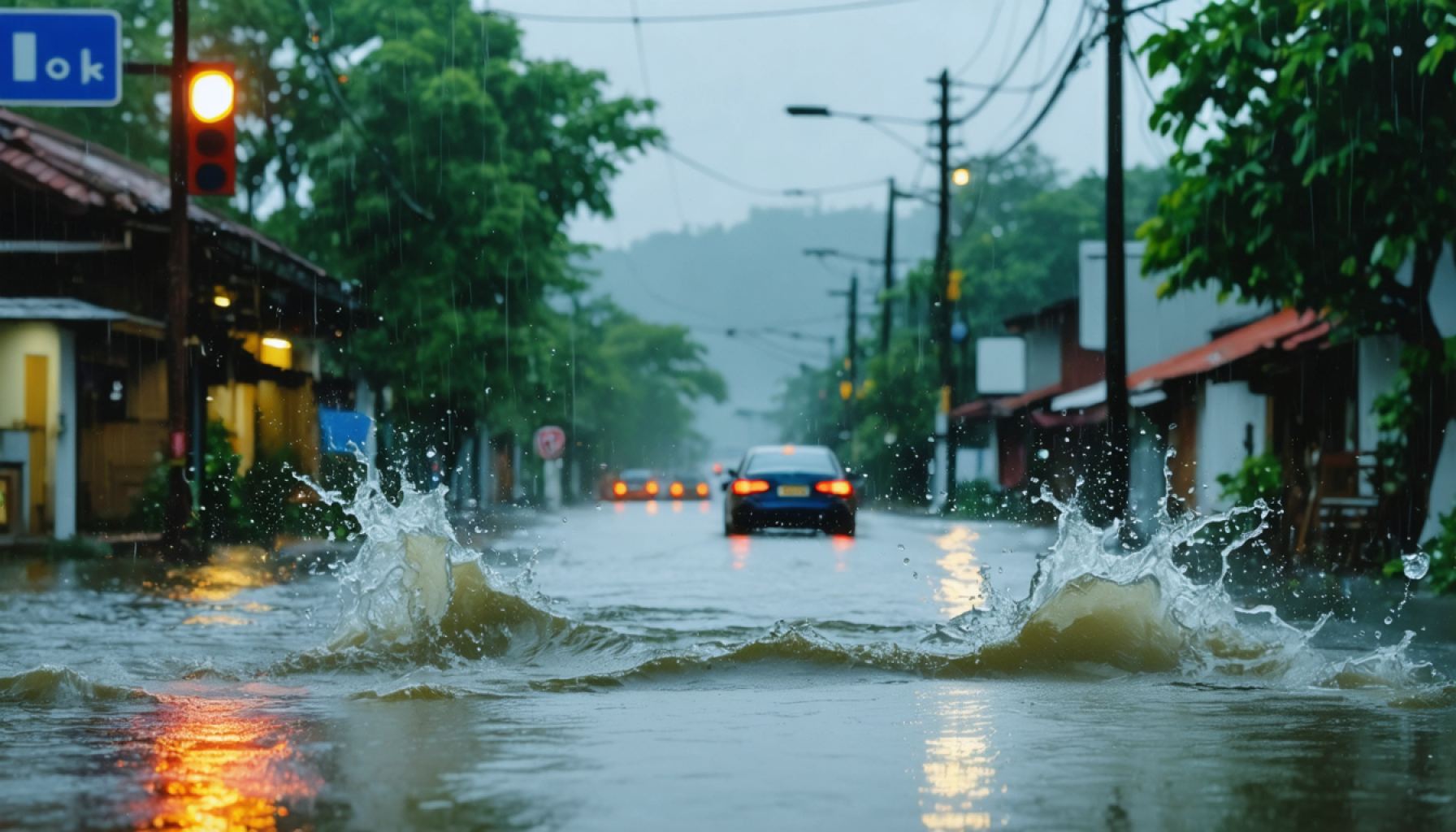
This image was generated using artificial intelligence. It does not depict a real situation and is not official material from any brand or person. If you feel that a photo is inappropriate and we should change it please contact us.
The Secret to Staying Safe during Sudden Floods and Torrential Rain
- Understanding flood warnings is crucial for ensuring personal safety and preparedness during severe weather conditions.
- Flood advisories signal potential disruptions, and while they may seem mild, they should not be ignored as they could develop into more severe situations.
- Flood watches indicate favorable conditions for flooding, prompting preparation without immediate alarm.
- Flash flood warnings necessitate immediate action, as they predict rapid water accumulation that can be life-threatening.
- During heavy rain, driving requires caution: use headlights, keep a safe distance, and avoid sudden movements to prevent skidding.
- Avoid water-covered roads; even a foot of water can sweep away a vehicle.
- If overwhelmed, pull over safely utilizing headlights and flashers, and follow the weather service’s advice.
Weather can shift from a gentle drizzle to torrents of rain in a heartbeat, turning tranquil streams into raging torrents. As rainwater gushes, even calm roads can transform into perilous traps. Understanding how to respond to flood warnings and advisories is crucial for survival.
Flood advisories may seem mild, but they’re harbingers of potential danger. While these warnings suggest that flooding might not merit alarm, they can still cause significant disruptions and even evolve into life-threatening scenarios if overlooked. On the other hand, flood watches hint that conditions are ripe for inundation, urging preparation but not panic.
Flash flood warnings, however, demand immediate action. Imagine a sudden onslaught of water, an unpredictable force sweeping across neighborhoods, capable of reaching unexpected areas in mere minutes. An ominous sign to seek higher ground without delay.
When rain pelts down relentlessly, and roads glisten with standing water, caution is vital. Enhance visibility by using headlights, maintaining safe distances, and avoiding abrupt moves that could lead to skidding. The first 30 minutes of rainfall can be the most treacherous; grime and oil create slick surfaces, demanding heightened alertness.
In overwhelming downpours, maintaining composure behind the wheel becomes a balancing act. Steer clear of large vehicles, whose spray shrouds vision, and resist the temptation to venture into waterlogged hazards. A momentary misjudgment can whisk away an entire car in just a foot of roiling water.
Amidst the deluge, hidden perils lurk. Overwhelmed by rain? Pull over safely; your guardianship lies in headlights, flashers, and distance from the road. Stay vigilant, heed the weather service’s advice, and embrace these guidelines to weather the storm safely, no matter the scale of nature’s fury.
How to Stay Safe and Prepared During Flood Alerts: Essential Tips and Precautions
How-To Steps & Life Hacks for Flood Preparedness
1. Understand the Warnings: Familiarize yourself with the types of flood alerts:
– Flood Advisory: Signals potential flooding. Stay informed and prepared for possible inconveniences.
– Flood Watch: Indicates possible flooding. Plan routes and keep an emergency bag ready.
– Flash Flood Warning: Means immediate danger. Evacuate to higher ground if advised.
2. Pack an Emergency Kit:
– Include essentials such as water, non-perishable food, a first-aid kit, a flashlight, extra batteries, and important documents.
3. Create a Family Plan:
– Ensure all family members know the evacuation route and a meet-up spot. Practice drills regularly.
4. Stay Informed:
– Keep a weather radio handy. Use apps and websites like National Weather Service for real-time updates.
5. Home Preparations:
– Elevate critical appliances and waterproof the basement. Have sandbags ready to prevent water entry.
Real-World Use Cases and Reviews
– Automobile Protection: From oilskinned roads to submerged pathways, cars face multiple risks. Vehicles like SUVs and trucks with high ground clearance are favored for flood-prone areas. But, regardless of vehicle type, always avoid driving through floodwaters.
– Community Solutions: Neighborhood flood preparedness programs that provide alerts and evacuation assistance are highly effective. Programs that educate the public, like those run by local emergency services, consistently receive positive reviews for their effectiveness in reducing flood-related harm.
Pros & Cons Overview
Pros:
– Staying informed and prepared reduces injury and property damage.
– A well-rehearsed emergency plan provides peace of mind.
Cons:
– Flood warnings may interrupt daily activities, causing inconvenience.
– Resources for preparation can be costly, though invaluable in emergencies.
Actionable Recommendations
– Maintain Vehicle Safety: Regularly check tire treads and brakes to ensure optimal performance in wet conditions.
– Monitor Local Channels: Stay alert and share warnings with your community. Peer networks can ensure wider reach and safety.
While natural elements like floods are beyond control, proactive measures can significantly enhance safety and resilience. Leveraging technology for weather alerts, preparing emergency supplies, and adhering to expert safety advice forms the crux of effective flood management and personal safety.